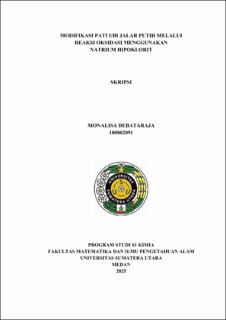Modifikasi Pati Ubi Jalar Putih Melalui Reaksi Oksidasi Menggunakan Natrium Hipoklorit
Modification of White Sweet Potato Starch Through Oxidation Reaction Using Sodium Hypochlorite
Abstract
Modification of white sweet potato starch were carried out through an
oxidation reaction between white sweet potato starch (Ipomoea Batatas Linneaus) and sodium hypochlorite (NaOCl). This research was conducted in two stages, namely the isolation of white sweet potato starch, and the modification of white sweet potato starch through an oxidation reaction using sodium hypochlorite at various active chlorine concentrations of 1%; 3%; 5% and 7%. The optimum NaOCl concentration in the oxidation of white sweet potato starch is at an active chlorine concentration of
5% NaOCl. The oxidized starch obtained was analyzed by the Degree of Oxidation Test, FT-IR Spectrophotometer, Solubility, Swelling Power, and Surface Morphology Test (SEM). The degree of oxidation (DO) at variations of active chlorine of 1%, 3%, 5% and 7% NaOCl were 0.632; 1.220; 1.604 and 1.396, respectively. The highest DO value in white sweet potato oxidized starch with 5% active chlorine was 1.604. Based on the FT-IR test, it was indicated by the presence of O-H absorption bands at wave number 3265.1 cm-1 and C=O at wave number 1632-1640 cm-1. The solubility values were 2.06%; 2.18%; 2.36% and 2.54%, respectively. The swelling power values were 5.54 g/g; 5.16 g/g; 4.66 g/g and 5.14 g/g, respectively. The results of surface morphology analysis on the microstructure of white sweet potato starch using SEM showed a more hollow granule surface.
Collections
- Undergraduate Theses [1420]

